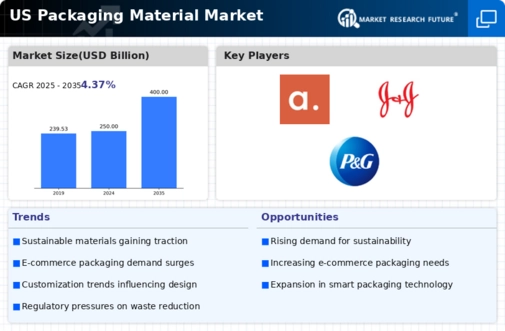E-commerce Growth and Packaging Needs
The rapid growth of e-commerce is significantly impacting the packaging material market, as online shopping continues to gain popularity among consumers. This trend necessitates the use of durable and protective packaging materials to ensure product safety during transit. The packaging material market is expected to see a surge in demand for packaging solutions tailored for e-commerce, with an estimated growth rate of 7% annually through 2026.. Companies are increasingly focusing on optimizing packaging designs to reduce shipping costs and enhance customer satisfaction. As e-commerce platforms expand, the need for efficient and sustainable packaging solutions will likely remain a key driver in the packaging material market.
Growth of the Food and Beverage Sector
The food and beverage sector is a significant driver of the packaging material market, accounting for a substantial share of overall demand. As consumer preferences shift towards convenience and ready-to-eat meals, the need for effective packaging solutions has surged. The market for food packaging is expected to reach approximately $50 billion by 2026, indicating a robust growth trajectory. This growth is largely attributed to the increasing consumption of packaged foods and beverages, which require innovative packaging materials that ensure product safety and extend shelf life. Consequently, manufacturers in the packaging material market are focusing on developing advanced materials that cater to the specific needs of the food and beverage industry.
Technological Advancements in Packaging
Technological advancements are reshaping the packaging material market, leading to the development of smarter and more efficient packaging solutions. Innovations such as active and intelligent packaging are gaining traction, allowing for enhanced product preservation and consumer engagement. For instance, the integration of QR codes and NFC technology in packaging enables brands to provide consumers with additional product information and interactive experiences. The packaging material market is expected to benefit from these advancements, as they not only improve functionality but also enhance the overall consumer experience. As companies invest in research and development, the market is likely to see a surge in innovative packaging solutions that meet evolving consumer demands.
Rising Demand for Eco-Friendly Packaging
The increasing consumer awareness regarding environmental sustainability is driving the demand for eco-friendly packaging solutions in the packaging material market. As more consumers prioritize sustainable practices, companies are compelled to adopt biodegradable and recyclable materials. This shift is reflected in the market, where eco-friendly packaging is projected to grow at a CAGR of approximately 5.5% through 2026. The packaging material market is witnessing a transformation as businesses seek to align their products with consumer values, thereby enhancing brand loyalty and market competitiveness. Furthermore, regulatory pressures are also influencing this trend, as governments implement stricter guidelines on plastic usage, pushing manufacturers to innovate and invest in sustainable alternatives.
Regulatory Compliance and Safety Standards
Regulatory compliance and safety standards are critical drivers in the packaging material market, as manufacturers must adhere to stringent guidelines to ensure product safety and consumer protection. The Food and Drug Administration (FDA) and other regulatory bodies impose specific requirements on packaging materials, particularly in the food and pharmaceutical sectors. This necessitates continuous innovation and adaptation within the packaging material market to meet these evolving standards. Companies are investing in research to develop materials that not only comply with regulations but also enhance product safety and shelf life. As regulations become more stringent, the packaging material market is likely to see increased demand for compliant and safe packaging solutions.














Leave a Comment